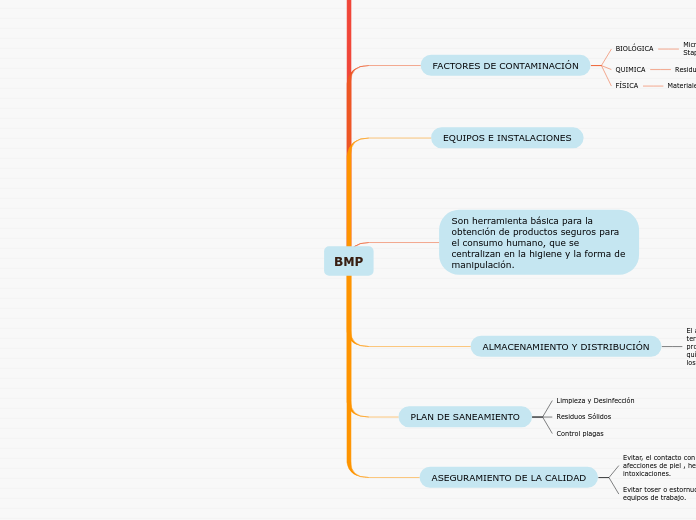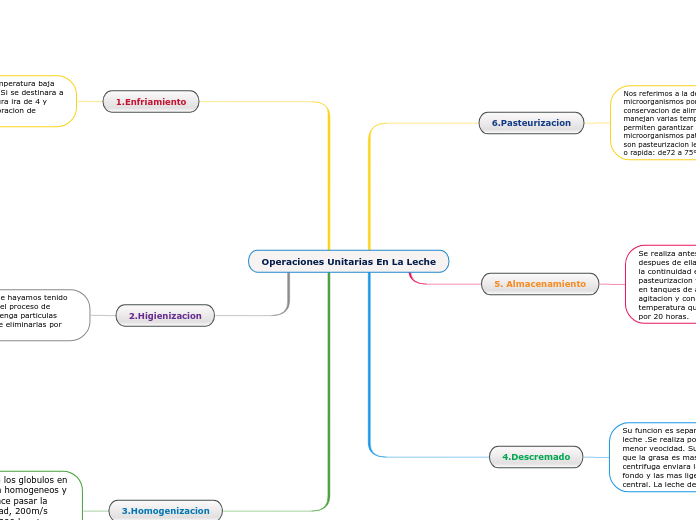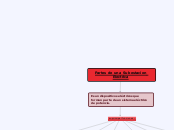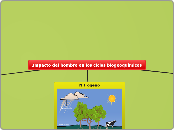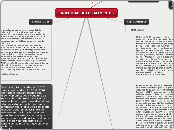BMP
To name your story, you have to think about the overall message and what you want your audience to understand from the story. Also, make it relevant and easy to remember.
ASEGURAMIENTO DE LA CALIDAD
Each story has a main character and that character usually needs to solve a problem or challenge. The character's challenge is the one that creates tension throughout the story.
Evitar toser o estornudar sobre los alimentos y equipos de trabajo.
Type in any other challenges which other characters in the story need to face.
Evitar, el contacto con alimentos si padece afecciones de piel , heridas, resfríos, diarrea, o intoxicaciones.
In most stories, there are 3 challenges. The number 3 is a mystical number symbolizing completeness. Try to come up with interesting challenges with which your character needs to struggle.
See a few examples below:
- turns into a werewolf at night
- is sent back in time
PLAN DE SANEAMIENTO
Control plagas
Residuos Sólidos
Limpieza y Desinfección
ALMACENAMIENTO Y DISTRIBUCIÓN
El almacenamiento y transporte de los alimentos terminados debe realizarse bajo condiciones que protejan los productos de contaminación física, química y microbiana, así como de los deterioros de los alimentos y del contenedor.
Examinar cuidadosamente los productos que se reciben y despachan.
Garantizar y mantener las temperaturas (Congelación –18°C a – 22°C Refrigeración de 0°C a 4°C).
Vehículos deben estar limpios, libres de desperdicios y olores.
Son herramienta básica para la obtención de productos seguros para el consumo humano, que se centralizan en la higiene y la forma de manipulación.
The middle of the story is where you add layers of complications that will lead to the end. Reveal more about the character's journey. Did their personality go through changes? How did they overcome the challenges? And as you build up the story’s central conflict, make it more personal to that character. Also, from the middle act, you have to lead into the final act.
EQUIPOS E INSTALACIONES
FACTORES DE CONTAMINACIÓN
The ending of a story is essential. We all know that if the ending is weak, what happened before loses its importance. So make it unpredictable, but fair. A resolved ending answers all the questions and ties up any loose threads from the plot.
FÍSICA
This is the closure section of the story.
See examples of possible outcomes below:
- all problems have been solved
- it's clear how each one of your characters ends up
- your main character is transformed by the challenge
Materiales Extraños.
Try answering these questions to come up with a closure:
- Have all the problems been solved?
- Is there a clear picture of what happens with each character in the story?
- Has the challenge transformed your main character?
- How do the characters feel in the end?
QUIMICA
This is the moment when the main character surpasses the last obstacle and finally faces their greatest challenge.
The climax usually follows one of these patterns:
- realization
- resolution
- choice
Type in your answer.
Residuos de desinfectantes, Lubricantes, grasa mecánica.
BIOLÓGICA
Microorganismos (Listeria, Salmonella, Escherichia coli, Staphylococcus aureus, Hongos, Parásitos , Virus.
MANIPULADOR DE ALIMENTOS
In the beginning of the story (or the exposition), you will need to introduce the setting and characters. You might also want to introduce the main conflict. This part of the story is important because it gives the reader necessary background information and maybe even a first insight into a character’s personality.
Persona que interviene directa o indirectamente, y aunque sea en forma ocasional, en actividades fabricación, procesamiento, preparación, envases, almacenamiento, transporte y expendio de alimentos.
The setting (time & place) of a story can change throughout the plot.
PRACTICAS HIGIÉNICAS DEL MANIPULADOR
Characters are essential to a good story. Usually, the protagonist(s) is/are the most affected by the plot. Introduce a character by focusing on their actions, interests, and occupation, as the physical appearance doesn't make a difference in most cases.
PARA EVITAR PELIGROS FÍSICOS O MATERIALES EXTRAÑOS
No llevar maquillaje.
El cabello debe permanecer limpio, corto y/o recogido, utilizar correctamente la redecilla.
No llevar barba.
No usar accesorios: Reloj, anillos, aretes, pulseras, escapularios, porta gafas, riñoneras, etc.
EN LOCKERS Y OFICINAS
No guardar ni consumir alimentos en Locker y Oficinas, Ejemplo: Galletas semanales, Postres de la Alimentación, entre otros.
PARA EVITAR PELIGROS MICROBIOLÓGICOS Y QUÍMICOS
Type in the name of your character.
No tocarse alguna otra parte del cuerpo mientras manipula alimentos, en caso de hacerlo lavarse las manos.
Add other qualities/attributes of the character.
No comer en las áreas de producción, No probar los alimentos,
a menos que este autorizado.
What is your character's main goal?
fight Evilfind lovedefeat his/her enemyrule the worldmake friendstime travelmake an awesome discoveryOther
No utilizar perfumes, cremas ni lociones.
Which traits best describe the character's personality? Choose more if necessary:
introvertedloyalkindindependentquick-thinkingadventuresomeidealisticsweet-naturedcalmrisk-takercreativewittystrictfussyweirdclumsyharshaggressivecarelessclingingcowardlycrueldeceitfulimpulsiveOther
Uñas de las manos cortas, limpias y sin esmaltes.
Choose the type of your chacter:
Protagonist (main character)Antagonist (main character's opponent)Flat (stereotypical character)Round (his/ her personality develops throughout the story)Static (doesn't evolve as a person throughout the story)Dynamic (dramatical change in personality)Confidant (the main character trusts him/ her)Foil (contrasting character who enhances the personality of another character)Other
